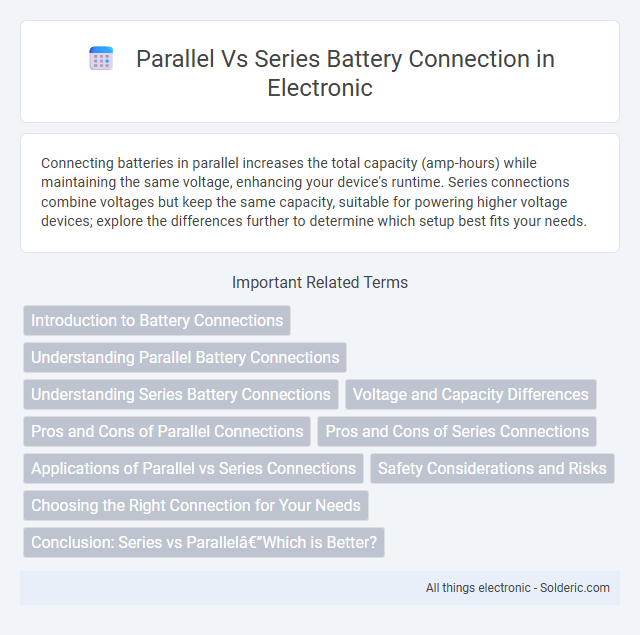Connecting batteries in parallel increases the total capacity (amp-hours) while maintaining the same voltage, enhancing your device's runtime. Series connections combine voltages but keep the same capacity, suitable for powering higher voltage devices; explore the differences further to determine which setup best fits your needs.
Comparison Table
| Feature | Parallel Battery Connection | Series Battery Connection |
|---|---|---|
| Voltage | Remains the same as a single battery | Sum of all battery voltages |
| Capacity (Ah) | Increases by the total of all batteries | Remains the same as a single battery |
| Current | Increases, sharing load among batteries | Same as single battery current rating |
| Application | Extends battery life, higher capacity devices | Higher voltage requirements |
| Advantages | Longer run time, redundancy, stable voltage | Higher voltage output, simple design |
| Disadvantages | Complex balancing, risk of uneven charging | Failure in one battery affects entire circuit |
Introduction to Battery Connections
Battery connections determine how voltage and capacity are combined in power systems, with parallel connections increasing overall capacity while maintaining voltage, and series connections increasing voltage while maintaining capacity. Understanding these configurations is crucial for optimizing battery performance in devices and renewable energy setups. Your choice between parallel and series connections affects runtime, power output, and system stability.
Understanding Parallel Battery Connections
Parallel battery connections involve linking multiple batteries positive terminal to positive terminal and negative terminal to negative terminal, maintaining the same voltage while increasing the total capacity and current output. This configuration is ideal for applications requiring extended battery life without increasing voltage, as the amp-hour (Ah) rating sums up, effectively doubling or tripling capacity depending on the number of batteries connected. Proper balancing and equal charge levels are crucial in parallel setups to prevent uneven discharge and prolong overall battery performance and lifespan.
Understanding Series Battery Connections
Series battery connections increase the total voltage output by connecting the positive terminal of one battery to the negative terminal of the next, effectively summing individual battery voltages while maintaining the same capacity (ampere-hours). This configuration is commonly used in applications requiring higher voltage levels, such as electric vehicles and renewable energy systems. Ensuring consistent battery specifications and proper insulation is critical to prevent imbalance and potential damage in series-connected batteries.
Voltage and Capacity Differences
Parallel battery connections maintain the same voltage as a single cell while increasing total capacity by summing the ampere-hours (Ah) of all cells, enhancing runtime. Series battery connections increase the total voltage by adding the voltage of each cell, but the capacity remains equal to that of a single cell. Understanding these distinctions is crucial for optimizing battery performance in applications requiring specific voltage and capacity configurations.
Pros and Cons of Parallel Connections
Parallel battery connections offer increased capacity and longer runtime by combining the amp-hour ratings of individual batteries while maintaining the same voltage, making them ideal for applications requiring extended power. They provide redundancy, so if one battery fails, others continue to supply power, enhancing reliability and safety. However, parallel connections demand careful matching of battery voltage and capacity to prevent imbalance, and uneven discharge rates may reduce overall battery lifespan.
Pros and Cons of Series Connections
Series battery connections increase voltage by adding the voltage of each cell, providing higher power output suitable for devices requiring more voltage. However, if one cell fails, the entire series circuit is compromised, which can reduce overall reliability and lifespan. Your application benefits from series connections when higher voltage is essential, but maintenance and monitoring are critical to avoid performance issues.
Applications of Parallel vs Series Connections
Parallel battery connections are ideal for applications requiring increased current capacity and longer runtime, such as electric vehicles or solar power systems, by maintaining voltage while multiplying amp-hour capacity. Series connections suit devices needing higher voltage output, like power tools and flashlights, since they add the voltage of each cell while keeping capacity constant. Your choice between parallel and series connections directly impacts performance and efficiency, depending on the specific voltage and current demands of your application.
Safety Considerations and Risks
Parallel and series battery connections present different safety considerations and risks. Series connections increase voltage but risk overheating and potential thermal runaway if one cell fails, while parallel connections enhance capacity but require balanced cells to prevent overcurrent and imbalance issues. Your battery management system must monitor voltage, current, and temperature to ensure safe operation and mitigate these hazards effectively.
Choosing the Right Connection for Your Needs
Choosing the right battery connection depends on your power and voltage requirements. Series connections increase voltage by adding the voltage of each battery, ideal for devices needing higher voltage, while parallel connections maintain voltage but increase capacity and current, perfect for longer runtime. Your choice should align with the specific demands of your application to optimize performance and battery life.
Conclusion: Series vs Parallel—Which is Better?
Series battery connections increase voltage by adding the voltage of each battery, ideal for devices requiring higher voltage output, while parallel connections maintain voltage but increase capacity and current, suitable for longer runtime applications. Your choice depends on the specific power requirements: choose series for higher voltage needs and parallel for extended battery life and stability. Understanding the differences ensures optimal performance and battery efficiency for your devices.
Parallel vs Series Battery Connection Infographic

 solderic.com
solderic.com